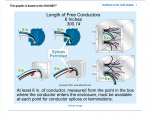Public Input No. 1407-NFPA 70-2020 [ Section No. 300.14 ]
300.14 Length of Free Conductors at Outlets, Junctions, and Switch Points.
At least 150 mm (6 in.) of free conductor, measured from the point in the box where it emerges from its raceway or cable sheath, shall be left at each outlet, junction, and switch point for splices or the connection of luminaires or devices.
The 150 mm (6 in.) free conductor is permitted to be spliced or unspliced. Where the opening to an outlet, junction, or switch point is less than 200 mm (8 in.) in any dimension, each conductor shall be long enough to extend at least 75 mm (3 in.)
outside the opening.
Exception: Conductors that are not spliced or terminated at the outlet, junction, or switch point shall not be required to comply with 300.14.
Statement of Problem and Substantiation for Public Input
I submitted a 'proposal' in 2008 [3-76 Log #1340 NEC-P03 Final Action: Reject] to require the free conductor to be unspliced, but the panel rejected my proposal.
Panel Statement

from 2008) The purpose of Section 300.14 is to permit access to the end of the conductor. Whether this conductor is spliced or un-spliced does not affect the length of this free end of the conductor. Many conductors originate inside the box and are spliced to other conductors within the box but extend out of the box for connection to a device of some kind.
Making this change would not permit this very common application. Even the exception to this section states that unspliced or unterminated conductors do not have to comply with 300.14.
Number Eligible to Vote: 13 Ballot Results: Affirmative: 13
However, nobody knows the panels intent and this has caused great stress for the industry; especially when the drywall installer damages conductors, or the remodel to the kitchen or bath results in the wall surface having a backsplash where the conductors (without splice) no longer provide 6 in. of free unspliced conductors. Some inspectors are requiring the
contractor to replace the wiring in the existing structure. Clearly that is not the panels intent but without clear language, the industry will continue to struggle.
Submitter Information Verification
Submitter Full Name: Mike Holt
Organization: Mike Holt Enterprises Inc
Street Address:
City:
State:
Zip:
Submittal Date: Tue Jun 02 12:10:44 EDT 2020
Committee: NEC-P03
Committee Statement
Resolution:
FR-9233-NFPA 70-2021
Statement: The free conductor is permitted to be a splice. The addition of this text makes that clear and free of interpretation.

